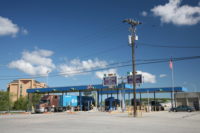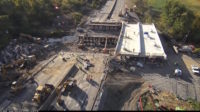The Pennsylvania Turnpike Commission is jumping into accelerated bridge construction (ABC) with both feet, tackling replacement projects scheduled at opposite ends of the Keystone State over the next two weeks.
Over the weekend of Sept. 22-25, Brayman Construction Corp., Saxonburg, Pa., will demolish a 66-year-old, 150-ft-long concrete box-beam bridge that carries the turnpike, or I-76, over Brush Creek in Beaver County, northwest of Pittsburgh. A new steel-plate-girder structure, designed by SPK Engineering Inc., Uniontown, Pa., will take its place, providing a safer crossing for approximately 40,000 vehicles a day.
The ABC process will be repeated the following weekend, Sept. 29-Oct. 2, in Lehigh County in eastern Pennsylvania. At the crossing of the turnpike's Northeastern Extension (I-476) over Crackersport Road, Road-Con Inc., West Chester, Pa., is scheduled to replace a 60-year-old, 131-ft-long steel I-beam structure with a steel-plate-girder structure designed by the Bethlehem, Pa., office of HDR Inc. The new bridge is designed to accommodate 30,000 vehicles per day.
STV Inc., Douglassville, Pa., is providing construction management and inspection for both projects.
Although the Pennsylvania Dept. of Transportation has used ABC for a variety of structure upgrades for several years, the upcoming replacements mark the first applications of the method along the 552-mile toll-road system. Successful completion of the work within both projects' scheduled 55-hour outages will be a priority, as the bridges' relatively remote locations will require lengthy detours of 60 to 80 miles. According to the Pennsylvania Turnpike Commission, the use of conventional methods would require up to 18 months of construction, including shifting work-zone patterns, potential weather disruptions and hazards to motorists and workers.
In a statement, turnpike CEO Mark Compton noted that the ABC process is "a safe, cost-effective way to replace bridges within a short timeframe while improving safety for workers and motorists in construction zones. It also eliminates the need for months or years of single-lane traffic patterns and other travel restrictions.”






Post a comment to this article
Report Abusive Comment